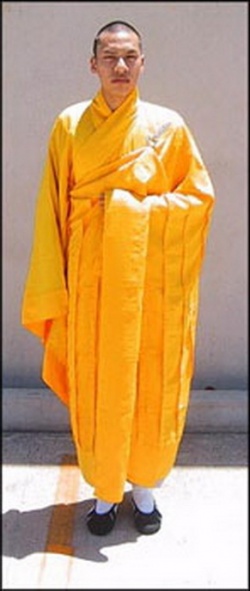The Eternal Buddha of Shin Buddhism
In Shin Buddhism, Amida Buddha is viewed as the eternal Buddha who manifested as Shakyamuni in India and who is the personification of Nirvana itself. The Shin Buddhist priest, John Paraskevopoulos, in his monograph on Shin Buddhism, writes:
'In Shin Buddhism, Nirvana or Ultimate Reality (also known as the "Dharma-Body" or Dharmakaya in the original Sanskrit) has assumed a more concrete form as (a) the Buddha of Infinite Light (Amitabha) and Infinite Life (Amitayus)and (b) the "Pure Land" or "Land of Utmost Bliss" (Sukhavati), the realm over which this Buddha is said to preside ... Amida is the Eternal Buddha who is said to have taken form as Shakyamuni and his teachings in order to become known to us in ways we can readily comprehend.'
John Paraskevopoulos elucidates the notion of Nirvana, of which Amida is an embodiment, in the following terms:
'... [Nirvana's] more positive connotation is that of a higher state of being, the dispelling of illusion and the corresponding joy of liberation. An early Buddhist scripture describes Nirvana as: ... the far shore, the subtle, the very difficult to see, the undisintegrating, the unmanifest, the peaceful, the deathless, the sublime, the auspicious, the secure, the destruction of craving, the wonderful, the amazing, the unailing, the unafflicted, dispassion, purity, freedom, the island, the shelter, the asylum, the refuge ... (Samyutta Nikaya)'
This Nirvana is seen as eternal and of one nature, indeed as the essence of all things. Paraskevopoulos tells of how the Mahaparinirvana Sutra speaks of Nirvana as eternal, pure, blissful and true self:
'In Mahayana Buddhism it is taught that there is fundamentally one reality which, in its highest and purest dimension, is experienced as Nirvana. It is also known, as we have seen, as the Dharma-Body (considered as the ultimate form of Being) or "Suchness" (Tathata in Sanskrit) when viewed as the essence of all things ... "The Dharma-Body is eternity, bliss, true self and purity. It is forever free of all birth, ageing, sickness and death" (Nirvana Sutra)'
To attain this Self, however, it is needful to transcend the 'small self' and its pettiness with the help of an 'external' agency, Amida Buddha. This is the view promulgated by the Jodo Shinshu founding Buddhist master, Shinran Shonin. John Paraskevopoulos comments on this:
'Shinran's great insight was that we cannot conquer the self by the self. Some kind of external agency is required: (a) to help us to shed light on our ego as it really is in all its petty and baneful guises; and (b) to enable us to subdue the small 'self' with a view to realising the Great Self by awakening to Amida's light.'
When that Great Self of Amida's light is realised, Shin Buddhism is able to see the Infinite which transcends the care-worn mundane. John Paraskevopoulos concludes his monograph on Shin Buddhism thus:
'It is time we discarded the tired view of Buddhism as a dry and forensic rationalism , lacking in warmth and devotion ... By hearing the call of Amida Buddha we become awakened to true reality and its unfathomable working ... to live a life that dances jubilantly in the resplendent light of the Infinite.'

